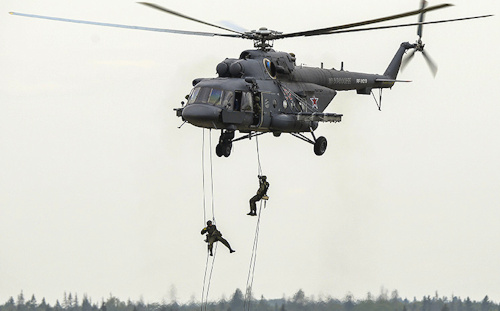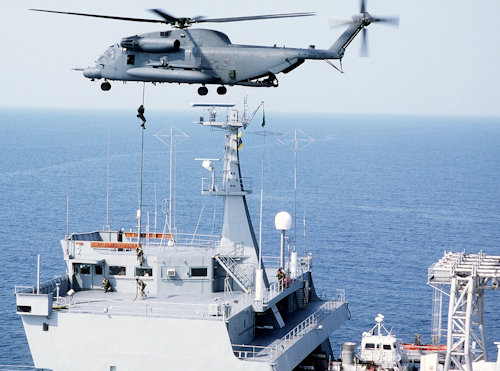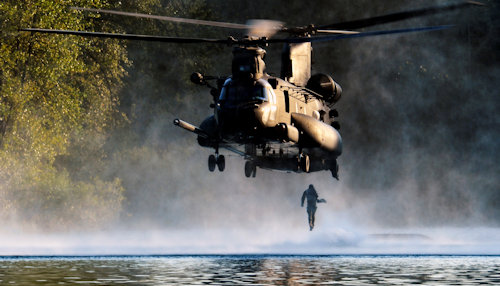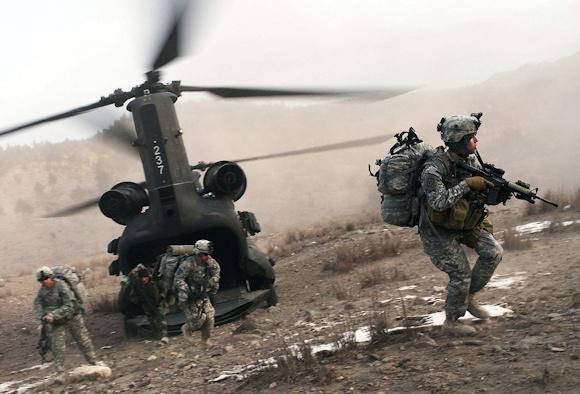Helicopters, by their nature, are a very versatile and highly flexible aircraft. For this reason they can cope with different operational needs and can therefore be used in several types of missions, including those in which it is necessary to take off and / or land because they can not use permanently dedicated structures or surfaces, or in any case set up and prepared even in temporary route.
Thanks to their recognized "tactical versatility", helicopters are regularly used by the armed forces and police forces around the world to carry out various tasks. The military helicopters, in particular, can be classified according to various characteristics but, to have an immediate and concrete idea, it is sufficient to know the "classification by weight", which determines its size also roughly, as well as the "role of operational use "for which they were designed.
Depending on your weight, helicopters can belong to one of the following 4 classes: light (2-4 tons), medium-light (5-8 t.), Medium-heavy (9-12 t.), Heavy (13- 16 t.).
 Projectually speaking, and in parallel, a specific helicopter model may have been conceived for a single and specific role (combat, ground attack, anti-submarine hunting, surface de-mining, aerotactic support, search and rescue ..), or for more roles of which one principal (multirole, exploration and reconnaissance, transport and disembarkation, transport troops and evacuation injured, escort and protection ...), if not even foreseeing the possibility of being able to implement, in the moment of need, a "temporary reconfiguration" aimed at make the helicopter able to provide those additional operational capabilities necessary for that particular mission. Naturally, it will be possible to refine and optimize its tactical and operational use considering also other factors and parameters (dimensions and dimensions, air flow of the rotors, type of turbines, armament, instrumentation on board, usable quota, power, speed, autonomy, rate of descent, with the provision of wheels or skids, load capacity, transport ...) that will better delineate the possibilities and constraints in the sphere of the type of mission to be carried out, also assessing the context within which it must be carried at the end (operational requirements, available time, distances involved, approach routes, rules of engagement, number of aircraft involved, day or night arc, meteorological situation, type of target, enemy presence ...) and with which eventual particular modes should to be carried out (hidden approach, need for air protection ...).
Projectually speaking, and in parallel, a specific helicopter model may have been conceived for a single and specific role (combat, ground attack, anti-submarine hunting, surface de-mining, aerotactic support, search and rescue ..), or for more roles of which one principal (multirole, exploration and reconnaissance, transport and disembarkation, transport troops and evacuation injured, escort and protection ...), if not even foreseeing the possibility of being able to implement, in the moment of need, a "temporary reconfiguration" aimed at make the helicopter able to provide those additional operational capabilities necessary for that particular mission. Naturally, it will be possible to refine and optimize its tactical and operational use considering also other factors and parameters (dimensions and dimensions, air flow of the rotors, type of turbines, armament, instrumentation on board, usable quota, power, speed, autonomy, rate of descent, with the provision of wheels or skids, load capacity, transport ...) that will better delineate the possibilities and constraints in the sphere of the type of mission to be carried out, also assessing the context within which it must be carried at the end (operational requirements, available time, distances involved, approach routes, rules of engagement, number of aircraft involved, day or night arc, meteorological situation, type of target, enemy presence ...) and with which eventual particular modes should to be carried out (hidden approach, need for air protection ...).
 Since the 50 years, military helicopters began to be significantly used in offensive operations, including those helicopters initially used for "troop transport" but which, thanks to some fairly simple structural changes and the positioning of suitable machine guns near the side doors, could be used in reconnaissance, infiltration, exfiltration, and air assault missions (Air Assault or Eliassalto, not to be confused withAirborne Assault or l 'Airland Assault, respectively the aviation and avioassalto carried out by the airborne troops). These operational capabilities by military helicopter components from various countries have become a long-established reality, a reality also proven by the presence on the market of various models of multirole helicopters specially dedicated (and armed). In order to carry out these operational activities, some armed forces also provide for the possession, both by pilots and by the "assaulters", of a special specialization. Ultimately, however, when there is an operational need to bring assault troops directly onto the target, ie at a specific point in a territory, on the roof of a building or on a ship (tactical action defined as Eliassalto) or infiltrate / exfiltrate troops into / from a hostile or enemy territory (tactical action defined as Insertion / Extraction), these particular tactical options are often used, based essentially on the use of helicopters, which significantly reduce the possibilities of discovery by part of the enemy. Incidentally, the term "infiltration" and the term "insertion" (and also the terms "exfiltration" and "extraction") are used as synonyms, however, it is recalled that we are talking about infiltration when different operative groups are "released" ( or "leave the vehicle" that is carrying them) and infiltrate in different points coming from different directions, even if their subsequent reunification is foreseen (to then direct in force on the objective), while we speak of insertion when one or more groups, even in succession, are "released" in a single specific point, but all coming from the same direction. However, referring to the helicopter it is more appropriate to speak of "insertion" and "extraction".
Since the 50 years, military helicopters began to be significantly used in offensive operations, including those helicopters initially used for "troop transport" but which, thanks to some fairly simple structural changes and the positioning of suitable machine guns near the side doors, could be used in reconnaissance, infiltration, exfiltration, and air assault missions (Air Assault or Eliassalto, not to be confused withAirborne Assault or l 'Airland Assault, respectively the aviation and avioassalto carried out by the airborne troops). These operational capabilities by military helicopter components from various countries have become a long-established reality, a reality also proven by the presence on the market of various models of multirole helicopters specially dedicated (and armed). In order to carry out these operational activities, some armed forces also provide for the possession, both by pilots and by the "assaulters", of a special specialization. Ultimately, however, when there is an operational need to bring assault troops directly onto the target, ie at a specific point in a territory, on the roof of a building or on a ship (tactical action defined as Eliassalto) or infiltrate / exfiltrate troops into / from a hostile or enemy territory (tactical action defined as Insertion / Extraction), these particular tactical options are often used, based essentially on the use of helicopters, which significantly reduce the possibilities of discovery by part of the enemy. Incidentally, the term "infiltration" and the term "insertion" (and also the terms "exfiltration" and "extraction") are used as synonyms, however, it is recalled that we are talking about infiltration when different operative groups are "released" ( or "leave the vehicle" that is carrying them) and infiltrate in different points coming from different directions, even if their subsequent reunification is foreseen (to then direct in force on the objective), while we speak of insertion when one or more groups, even in succession, are "released" in a single specific point, but all coming from the same direction. However, referring to the helicopter it is more appropriate to speak of "insertion" and "extraction".
 For these operations, various techniques are envisaged which are substantially linked to the flight altitude to which the helicopter must be positioned, predominantly "in stationary flight" (also called "in hovering" or "in fixed-point flight"), to carry out the release or recovery of men. The share is obviously linked, as well as to the type of mission, to various factors including the possibility or not of landing (or fitting) by the helicopter, the nature of the surface, the visibility, the wind at altitude and the ground , from the possible presence of obstacles and their height, from the time available and the number of men to be released or recovered. Incidentally, it should be noted that all the techniques of release and recovery require specific measures within the helicopter (sometimes even outside) to make sure the various types of anchorage, braghe, ropes, cables, hooks, rings , bars, tubes, karabiners and "quick release" devices (in case of emergency) as well as a radio coordination between the pilot (for the correct positioning of the helicopter and the maintenance of the "verticalization" of the ropes), the operator flight (safety and equipment set-up) and the "release / recovery director" (security officer and movement of men in issue or in recovery).
For these operations, various techniques are envisaged which are substantially linked to the flight altitude to which the helicopter must be positioned, predominantly "in stationary flight" (also called "in hovering" or "in fixed-point flight"), to carry out the release or recovery of men. The share is obviously linked, as well as to the type of mission, to various factors including the possibility or not of landing (or fitting) by the helicopter, the nature of the surface, the visibility, the wind at altitude and the ground , from the possible presence of obstacles and their height, from the time available and the number of men to be released or recovered. Incidentally, it should be noted that all the techniques of release and recovery require specific measures within the helicopter (sometimes even outside) to make sure the various types of anchorage, braghe, ropes, cables, hooks, rings , bars, tubes, karabiners and "quick release" devices (in case of emergency) as well as a radio coordination between the pilot (for the correct positioning of the helicopter and the maintenance of the "verticalization" of the ropes), the operator flight (safety and equipment set-up) and the "release / recovery director" (security officer and movement of men in issue or in recovery).
The techniques in question, some of which are included in the generic "HRST" (Helicopter Rope Suspension Techniques), are as follows:
Landing (Landing), Deck Landing (Appontaggio) and Take-Off (Take off). The helicopter, depending on its technical constraints, operating parameters and environmental conditions, lands resting on the ground permanently (even within a certain percentage of slope) or on a surface or on the deck of a ship (in navigation, but within a certain number of roll and pitch degrees of the ship itself) by releasing or recovering men and materials;
HHMAD (Heli Hanging in Mid-Air and Debarking / Disembarking - Landing / Releasing on the ground). The helicopter, remaining in stationary flight, touches the ground (leaning slightly but not resting), or remains at the maximum altitude of about 1 meter from the ground, so as to allow personnel to jump directly to the ground. In cases of tactical emergence this technique can also be used for a very fast re-boarding and immediate exfiltration;
 Helocast (Jump to the sea). The helicopter remains stationary at an altitude of 2 / 3 meters from the surface of the sea (lake or river) and the personnel jump directly into the water. Any pneumatic boats may also be thrown into the water;
Helocast (Jump to the sea). The helicopter remains stationary at an altitude of 2 / 3 meters from the surface of the sea (lake or river) and the personnel jump directly into the water. Any pneumatic boats may also be thrown into the water;
Fast Rope (descent with "Barbettone" or "Canapone"). As part of the FRIES techniques (Fast Rope Insertion and Extraction System) it also takes the word FDR (Fast Descent Rope). This technique is implemented by positioning the helicopter in stationary flight at a height that can vary from 5 to 15 meters. A large synthetic rope (Rope), no less than 30 mt, is hooked and secured on the helicopter. and with a diameter of not less than 4.4 cm., which is substantially thrown out and dropped to the ground at the intended point. The men in release, holding firmly with hands and feet on the rope (without having to have additional equipment for the descent), they slide quickly to the ground. Apart from the combat equipment and suitable anti-abrasion gloves for the hands, this technique does not require any type of harness or carabiner to be quickly freed, or with which to traffic, just touched the ground. The Fast Rope is rightly considered the simplest and fastest technique that allows a very fast descent, on a single rope, of numerous men (on average 10 men in 15 / 20 seconds). The weight of the rope itself also guarantees a certain stability of descent in the whirlwind of air generated by the helicopter blades. This technique, however, has its limitation when it is necessary to have a medium-heavy backpack (over 20Kg.) On the shoulders, which could lead to an imbalance of the body during the descent or a fall in the "Landing" on uneven, slippery, rocky or sloping terrain;
 Rappelling / Abseiling o Helirappel (Descent with mountaineering technique). The main 2 descent techniques are used (and for this reason they are called "ropes") using polyamide fiber ropes, commonly called "mountaineering ropes", with a diameter from 8 to 11 mm. and a minimum length of 60 meters, which allow a descent from heights even higher than 50 meters:
Rappelling / Abseiling o Helirappel (Descent with mountaineering technique). The main 2 descent techniques are used (and for this reason they are called "ropes") using polyamide fiber ropes, commonly called "mountaineering ropes", with a diameter from 8 to 11 mm. and a minimum length of 60 meters, which allow a descent from heights even higher than 50 meters:
single rope descent (single rope / line technique) with a static rope;
rappelling (double rope / line technique) with a dynamic rope.
Both techniques require, in addition to the combat equipment, specific additional harnesses (low harness to the pelvis in the absence of a high backpack / harness in the presence of a backpack that allows a higher coupling to prevent the body from overturning during the descent), carabiner with safety and tactical descender (for a quick release, the self-locking device is not placed under the descender). In general terms, the technique of abseiling is anyway preferred as it is by its nature safer and furthermore guarantees proper friction between the ropes thus allowing a more controlled descent. It should now be remembered that every rope, or rope that one wants to say, must have its own anchor point on the helicopter, which means that every man must have his "descent station". It follows that this factor is decisive for determining how many men can be infiltrated with that type of helicopter and with this type of technique ... and, consequently, how many helicopters would be needed to be able to transport and infiltrate a possible large operating group.
 SPIE (Special Patrol Insertion / Extraction) (Insertion / Extraction of Special Patrol). It is a technique used to quickly infiltrate and exfiltrate a "Special Recognition" Patrol (in reality it is almost exclusively used for exfiltration). The helicopter is connected to a particular rope, similar to that of the Fast Rope but much longer, in the final part of which, at a regular distance, there are a number of steel carabiners (average 12) to which the staff, equipped of a special harness, it is hooked when the helicopter is lowered (to allow the hooks) and then get up and proceed to the infiltration. The staff remains hung in the air during the entire exfiltration. The technique is recognizable as soon as you see a helicopter in flight with a long rope at the end of which a certain number of men are hanging, more or less clustered, which, to stabilize your body, widen your arms and legs (hence the name initial of STABO - STAbilized Body, also called SRS-STABO Rig System).
SPIE (Special Patrol Insertion / Extraction) (Insertion / Extraction of Special Patrol). It is a technique used to quickly infiltrate and exfiltrate a "Special Recognition" Patrol (in reality it is almost exclusively used for exfiltration). The helicopter is connected to a particular rope, similar to that of the Fast Rope but much longer, in the final part of which, at a regular distance, there are a number of steel carabiners (average 12) to which the staff, equipped of a special harness, it is hooked when the helicopter is lowered (to allow the hooks) and then get up and proceed to the infiltration. The staff remains hung in the air during the entire exfiltration. The technique is recognizable as soon as you see a helicopter in flight with a long rope at the end of which a certain number of men are hanging, more or less clustered, which, to stabilize your body, widen your arms and legs (hence the name initial of STABO - STAbilized Body, also called SRS-STABO Rig System).
Swarming Rope (Cluster rope). It is part of the FRIES technique (Fast Rope Insertion and Extraction System) and also takes the word "FRIES" because, theoretically, the rope used could also be used for the Fast Rope. It is a technique that is substantially identical to the aforementioned SPIE, but changes some details on the rope: the rings are made of synthetic fiber and can present different positions along the rope in order to allow the hooking of the "cluster" men (hence the name) . With a slightly thinner rope, the technique is called RPX (Rapid Personnel Extraction). This technique is often used by various armed forces solely as a "training event";
 Ladder / Jacob's Ladder (Biscagine / Biscaglina mobile ladder). The biscuit is used mainly for the recovery of personnel. Since the recovery is always "slow", we look for a particularly suitable stationary flight quota (on average it is around the 4 / 5 meters) and to reduce the portion of the biscuit in the air (thus reducing the rise or fall times) and for avoid the excessive movement of the biscuit itself;
Ladder / Jacob's Ladder (Biscagine / Biscaglina mobile ladder). The biscuit is used mainly for the recovery of personnel. Since the recovery is always "slow", we look for a particularly suitable stationary flight quota (on average it is around the 4 / 5 meters) and to reduce the portion of the biscuit in the air (thus reducing the rise or fall times) and for avoid the excessive movement of the biscuit itself;
Rescue Hoist (Rescue winch with steel cable, hook and braghe). The procedures are identical to those used for rescue operations. For military operations, given the times involved, the release and recovery of a very limited number of personnel is expected and the helicopter does not position itself at a height higher than 30 meters.
Parachute Jump Technique (Launch with parachute, both hemispherical shell type and wing profile). It can be done both in "automatic opening technique with tie rope" and in "free fall technique". However, the launch with a tie rope requires particular predispositions so that the constraint rope, once free, does not go between the blades or the rotor of the helicopter. The launch with the parachute from the helicopter could have an operative meaning if carried out by a quota of a few hundred meters ... but then, apart from very particular cases, it is worth employing a fixed wing aircraft prepared for launching paratroopers or getting off share the helicopter using the techniques mentioned. It is no coincidence that the launch of paratroopers from the helicopter is often carried out as a "training event" in the specialist field or as a "demonstration event" in the promotional sphere.
Rev. Admiral Marco Bandioli

(photo: US Marine Corps / Armada de México / Mod Russian Fed / US Army / US Navy / US Air National Guard / web)
Also read: "Military body combat systems. Requirements and prerogatives"
Also read: "The pneumatic boats and their tactical use"
Also read: "Naval Boarding Party: The Modern Arrays"












